No wonder that Formatville's motto is:
"Live by its 10 commandments or" - like Donnie Brasco would say - "Fuhgeddaboudit"
So if you want YOUR screenplay to be read and not tossed, apply these script formatting guidelines. Today the fifth commandment.
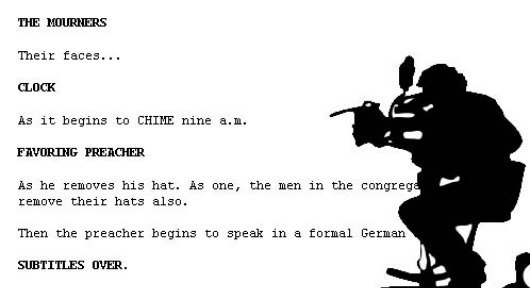
We asked our format expert, Matt, aka Formatman, to lead us through the 10 formatting commandments.
If you missed the introduction to this series of articles, you may want to check it out first.
Here is the link to Part 1, where it all started.
After reading this article you will know:
-- why you should NOT use camera directions in your screenplay,
and
-- how to direct without using camera directions
Whatascript:
I've seen screenwriters filling their screenplay format with camera instructions. This seems to go against this fifth commandment. What's your take on it?
Formatman:
I've seen those. It looks often like this:
Zoom on the car. Close on Mary. Angle on Mike. The camera follows ...
After a while I'm usually left with one question to the screenwriter:
Tell me again, what's your screenplay about?
So do NOT do that. Don't use camera instructions in your screenplay format or if you do, keep them to a strict minimum and only, if you can't get the same result as explained below.
Whatascript:
Why?
Formatman:
2 reasons:
Keep in mind, that a reader is putting the pieces of your script together in his mind, and that reader is filling in all necessary data.
He "writes" your script, visualizes your story.
When you add camera directions to your screenplay format, you basically clog your script with something outside of the drama at hand - outside of what is necessary to paint the scene and move the action/drama forward.
By doing so, you risk tangling up what's in the reader's mind.
You take the reader out of the story to have him deal with how you want the story to be told.
It can only dampen the pace of your screenplay, the unfolding drama, and the reader's favorable reaction.
Whatascript:
There are moments you have a very detailed picture in mind and you want to convey it to the reader.
Is there something in terms of screenplay format that you can use without taking the reader out of the story he's visualizing?
Formatman:
Yes. This is called a secondary scene heading. It allows you to direct the story without using camera directions.
In screenplay format, a Secondary scene heading, called sometimes secondary slug line, happens within a Master scene heading.
As we saw in the second commandment of screenplay format Master scene heading is a one line of text in a screenplay that precedes the description of a scene (e.g. INT. ADAM'S HOUSE - DAY).
It gives a context to the whole scene, as if everything that happens in it - what is seen, what is heard and where it all happens - is filmed in a single continuous shot, a master shot.
Whatascript:
In a screenplay format, what is the relation between master scene heading and secondary scene heading?
Formatman:
Within this master shot - this master scene heading - you may want to draw the attention of the reader to a sub location, a person, an object, a time period or a point of view. That's what secondary scene headings are for.
Whatascript:
Let's start with sub location. Can you give an example?
Formatman:
This is an extract of the screenplay 8MM written by Andrew Kevin Walker.
INT. MIAMI AIRPORT, TERMINAL -- DAY Amongst the weary tourist families and solitary businessmen sits TOM WELLES, middle-aged, hair neat, suit crisp and gray. He's eating crackers from a cellophane package, sipping soda from a paper cup, watching an ARRIVAL GATE. AT THE GATE PASSENGERS arrive: the paunchy, graying men of First Class leading the pack, except for a handsome YOUNG REPUBLICAN poster boy hurrying along. ACROSS THE TERMINAL Welles gets up and FOLLOWS...
In terms of screenplay format "AT THE GATE" and "ACROSS THE TERMINAL" are secondary scene headings.
Both are sub locations of the master scene heading, the master shot, "MIAMI AIRPORT, TERMINAL"
Whatascript:
I noticed in some screenplay formats that screenwriters used "zoom on", "close on" and "angle on" to get the reader's attention on a person or an object.
How do you achieve that goal with secondary scene headings?
Formatman:
Let me show you one example on how Earl W. Wallace, William Kelley, Pamela Wallace did that in the screnplay "Witness".
Notice how they bring the focus on a character or an object within the scene, how they tell the reader what is important in the scene.
And they achieve all that without explicitely directing the camera.
In this extract, "RACHEL LAPP", "THE MOURNERS", "CLOCK", "FAVORING PREACHER" are all secondary scene headings.
INT. LAPP FARMHOUSE Partitions have been removed, making the central rooms of the farmhouse a spacious hall. The place is packed, a hundred- fifty or more Amish, all sitting in absolute silence on rows of wooden benches. A wooden coffin rests on a bench in the f.g., and near it the close relatives of the deceased occupy a special Place. RACHEL LAPP
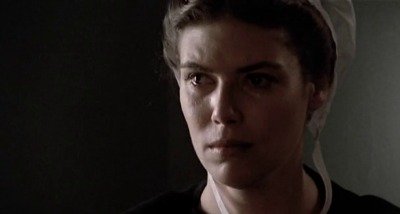
A young woman of perhaps twenty-seven. Her face is pale and drawn. In happier circumstances, although there haven't been too many of late in Rachel's life, we would see a robust, sensual woman of full figure, spirit and intelligence. Eight-year-old SAMUEL LAPP flits next to his mother; he would appear stunned, possibly not entirely comprehending events. And the patriarch, ELI LAPP; his stubborn, weathered - yet not unkind - features grief-stricken. THE MOURNERS Their faces...
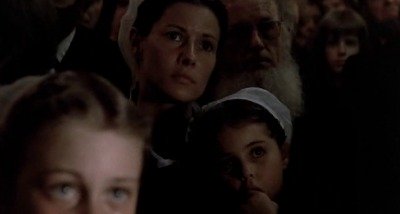
CLOCK As it begins to CHIME nine a.m. FAVORING PREACHER As he removes his hat. As one, the men in the congregation remove their hats also.
This is another example. This time from "Broken Arrow" written by Graham Yost.
In this case "A PARK RANGER TRUCK" and "A RANGER" are secondary headings.
EXT. CANYONLANDS NATIONAL PARK, UTAH - NIGHT Bright moonlight shows a campfire burning at the edge of an escarpment, the Colorado River a thousand feet below. Near the campfire is an Army surplus tent. Next to it, an easel holds a painting in progress. A PARK RANGER TRUCK Drives up, stops. The driver's door open, and out gets... A RANGER We don't see his face in the dark. He switches on a flashlight, walks over and taps on the tent.
Whatascript:
In the examples you gave, the focus was on one individual (a ranger) or on a group (the mourners).
How would the screenplay format look like if you wanted to draw the attention to two people at the same time?
Formatman:
You write the names of the characters next to each other and separate them with a slash.
You can however only do that if the characters are next to each other and can be in the same shot.
This is an example from Witness again.
RACHEL / SAMUEL They can't help but watch the confrontation between Donahue and Book... although they're keeping the volume down, it's obviously intense and angry: SAMUEL (alarmed) Momma... are they angry with us. RACHEL (reassuring, but hardly in her own mind) No... No. It is just the English way.
Whatascript:
In above examples, our attention gets drawn to some objects - like the clock on the wall or the park ranger truck. What if you want to show something on a screen.
How to do that in terms of screenplay format?
Formatman:
Use the secondary scene heading INSERT.
This is an example from The Bourne Identity written by Tony Gilroy and William Blake Herron.
RESEARCH TECH #1 (he's hit paydirt) Sir... CONKLIN (turning back --) What's that? RESEARCH TECH #1 It's an angle of the street -- some sort of alleyway -- you can just... CONKLIN Enhance it. INSERT -- THE MONITOR -- as the image enlarges to fill the screen. And there's Bourne. And the little red car. And Marie.
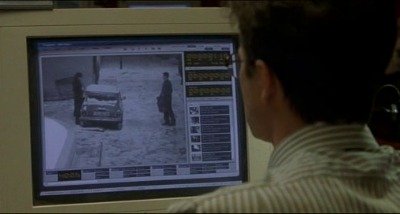
Whatascript:
You covered so far 2 aspects of secondary headings: how to draw the attention of the reader to a sub location and to a person or an object.
How do you use secondary headings with time?
Formatman:
Let me give you 2 examples:
The first one is from "Nick of Time" written by Patrick Sheane Duncan. In this example of screenplay format "THE TIME" is a secondary heading.
INT. UNION STATION - DAY - 12:06PM Union Station, that gorgeous fifty-year-old monument to Art Deco/California Mission architecture. Still beautiful. Still grand. A sign at one of the departure/arrival gates in the main concourse-says the "San Diegan", number 2 64, is due at 12:00. Set above the gates, a big clock - six feet in diameter. THE TIME - 12:06. We see the big hand slam into "7".
Later on, the words "THE TIME" are omitted from the screenplay format and only the time of the day is written on a separate line.
GENE glances at the bedside clock. 1:19. He looks back to the Governor.
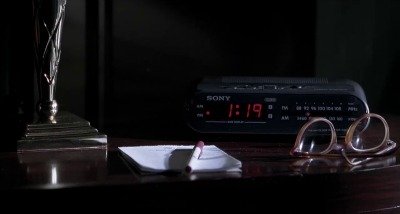
The second example is from "Erin Brockovich", written by Susannah Grant.
In this extract of screenplay format "LATER IN HER TESTIMONY" and "STILL LATER" are secondary scene headings.
INT. SOUTHERN CALIFORNIA COURTROOM - DAY Erin is on the stand, wearing the most conservative thing she owns: a red, form-fitting mini dress, telling her story to Ed, who's questioning her. ERIN I was pulling out real slow, and out of nowhere, his Jaguar comes racing around the corner like a bat outta hell ... She glances at the defendant's table, where a DOCTOR sits nobly in surgical scrubs. His WIFE and two beautiful KIDS are behind him. A frigging Norman Rockwell painting. LATER IN HER TESTIMONY: ERIN They took some bone from my hip and put it in my neck. I didn't have insurance, so I'm about seventeen thousand in debt right now. STILL LATER: ERIN ... couldn't take painkillers cause they made me too groggy to take care of my kids.
See also the 2nd formatting commandment: "Thou shalt not let the reader get lost" for the use of time within a master scene heading.
Whatascript:
At the beginning of this interview you mentioned that secondary headings can be used as well to reflect the point of view (POV) of a character. How do you do that?
Formatman:
Let's go back to the screenplay "Witness" for an example.
INT. TRAIN (MOVING) As Samuel spots something out of the window that causes him to light up. SAMUEL Look, Mama...! HIS POV THROUGH WINDOW A road runs parallel to the train track, and Hochstetler in his wagon urges his horse almost to the gallop as he attempts to keep pace with the train. BACK TO SCENE As Rachel smiles. RACHEL I see, darling. And Samuel cranes to look back, waving, for as long as he can.
In this example, Earl W. Wallace, William Kelley, Pamela Wallace chose to use a secondary scene headings "HIS POV THROUGH WINDOW" followed by a "BACK TO SCENE".
In Good Will Hunting Matt Damon and Ben Affleck just included the Point of View in the scene. This shows the flexibility of screenplay format and that all rules are not set in stone.
Push in on Will who sees something O.S. Will's P.O.V. reveals BOBBY CHAMPA and his friends walking down the street. One of them casually lobs a bottle into a wire garbage can. It SHATTERS and some of the glass hits a FEMALE PASSERBY who, although unhurt, is upset. CHUCKIE What do we got? WILL I don't know yet. Will's P.O.V.: The woman says something to Bobby. He says something back. By the look on her face, it was something unpleasant.
See also the 6th formatting commandment: "Thou shalt cut to the chase" for the use of POV with binoculars.
Formatman:
A secondary scene heading is always in CAPITAL letters and preceded and followed by one blank line (instead of two for a master scene heading).
Whatascript:
This concludes our interview on this fifth formatting commandment "Thou shalt direct without using camera directions". Thank you, Formatman.
Formatman:
May the Format be with you!

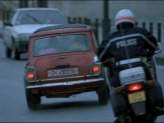
It's all about car scenes and how to write them (e.g. inside, outside, INT./EXT., in motion) And it includes a Top 6 Common Car actions.

It's all about flashback. The controversy around it, 7 key components to make it effective, when to use it, and how to test ride it.

Discover how to write dialogue lines in a foreign language. And deal with sign language, accent and translation.
Picture and screenplay extracts:
-- "8MM": Andrew Kevin Walker (screenplay)
-- "Witness": Kelly McGillis (Rachel), Peter Weir (director), John Seale (director of photography), Earl W. Wallace, William Kelley, Pamela Wallace (screenplay)
-- "Broken Arrow": Graham Yost (screenplay)
-- "The Bourne Identity": Doug Liman (director), Oliver Wood (director of photography), Tony Gilroy and William Blake Herron (screenplay)
-- "Nick of Time": John Badham (director), Roy H. Wagner (director of photography), Patrick Sheane Duncan (screenplay)
-- "Erin Brockovich" - Susannah Grant (screenplay)
-- "Good Will Hunting" - Matt Damon & Ben Affleck (screenplay)
Go from Screenplay Format to Whatascript! Home page
* Inception, screenplay written by Christopher Nolan